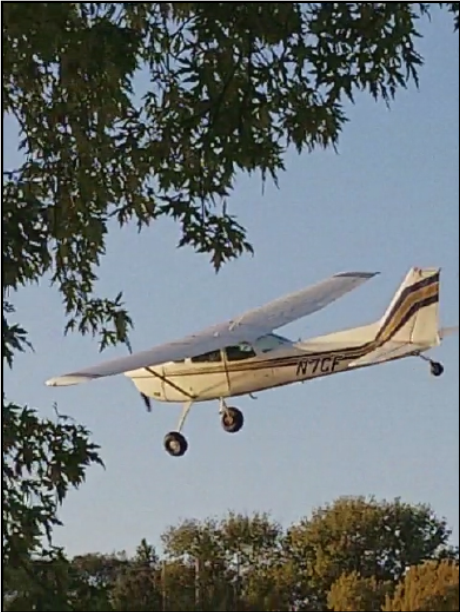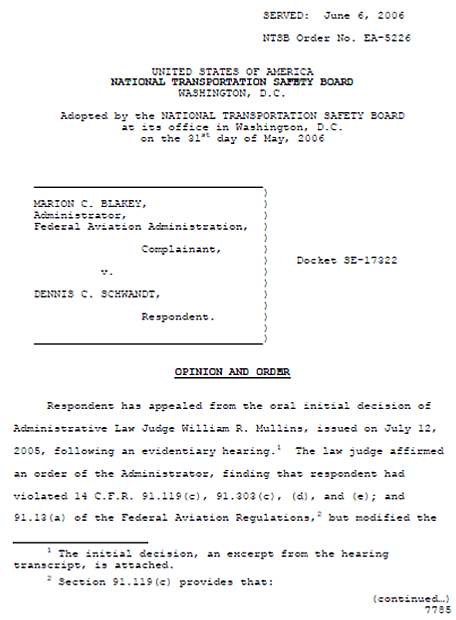 by jeff edwards
by jeff edwards
Many LOBO members and lancairtalk.net subscribers know that I have sparred with others over the practice of low-altitude flying. This includes buzzing airports, houses, friends etc. While researching for this article and a presentation I gave on the subject I found that this subject is debated by others, as well. One person I debated years ago said that this practice is “perfectly safe.” So let’s start the discussion there. Is low altitude flying, often called “maneuvering flight” by the NTSB, or sometimes called “buzzing”, or to borrow a term from the Navy, “flat hatting,” perfectly safe?
The Navy banned low altitude flying or “flat hatting” decades ago because of the aircraft and aircrew losses they suffered. The Navy wisely enshrined their opposition to such flying in OPNAVIST 3710.7 under part 5.5.1.6 titled Flat Hatting, which noted:
“Flat hatting or any maneuvers conducted at low altitude and/or a high rate of speed for thrill purposes over land or water are prohibited. Any acts conducted for thrill purposes are strictly prohibited.”
That same publication also included part 5.1.3, Unusual Maneuvers Within Class B, C, or D Airspace:
"Pilots shall not perform or request clearance to perform unusual maneuvers within class B, C, or D airspace if such maneuvers are not essential to the performance of the flight. ATC personnel are not permitted to approve a pilot's request or ask a pilot to perform such maneuvers. Unusual maneuvers include unnecessary low passes, unscheduled fly-bys, climbs at very steep angles, practice approaches to altitudes below specific minimums (unless a landing is to be made), or any so-called flat hatting wherein a flight is conducted at a low altitude and/or a high rate of speed for thrill purposes.”
Even though the practice is banned, the Navy lost a T-45 and two pilots last year for this behavior. The Air Force lost two pilots on April 3, 2004 at Savannah, GA in a T-6 Texan II for similar reasons.
The 2017 Nall Report issued by AOPA for data from 2014 reported 53 accidents (29 fatal) involving maneuvering flight. The report's authors noted:
“The great majority of fixed-wing maneuvering accidents, whether losses of control or collisions with obstructions, are initiated at low altitude. Some occur in the traffic pattern, but many of the crashes following unintended stalls and nearly all collisions with power lines, broadcast towers, and ridgelines arise directly from the pilot’s decision to fly needlessly low in inappropriate locations, making spins unrecoverable and leaving the airplane vulnerable to obstacles that could easily have been overflown. Very often these sudden impacts are not survivable, so maneuvering accidents are consistently one of the two top causes of deaths in general aviation.”
The Lancair fleet has suffered more than a few of these kinds of accidents (usually fatal). Years ago a 15,000 hour ATP rated Lancair 360 pilot buzzed his house in Placerville, California after picking up his daughter from college, his goal was to let his wife know they were home. The pilot pitched up into a steep attitude, stalled the aircraft and crashed in his neighbor’s front yard. Similar results occurred to the pilot of VH-HTD in New South Wales in 1993. Another 360 pilot perished when he lost control after buzzing a runway in Texas in 2004. The pilot of another 360 was seen performing low-altitude aerobatics when he lost control and spun in to the ground killing himself and a passenger.
The following is an excerpt from an NTSB report:
“On May 11, 1999, at 1000 central daylight time, a Campbell Lancair 320, N6111, collided with a tree and the ground during climb out from the Reeves Airport in Tallessee, Alabama. The personal flight was operated by the pilot under the provisions of Title 14 CFR Part 91 with no flight plan filed. Visual weather conditions prevailed at the time of the accident. The commercial pilot was fatally injured, and the airplane sustained substantial damage. According to a friend of the pilot, who was located at the Reeves Airport at the time of the accident, the purpose of the flight was to demonstrate a high speed, low pass over the runway. The pilot's friend reported that, during climb out there was a short radio conversation with the pilot followed by an abrupt end to the conversation. At this point, the airplane entered a nose-up attitude followed by a nose-down attitude. Another witness reported that the airplane entered a counter clockwise spin. The airplane collided with the ground and was located in a wooded area with the nose section still in a nose-down attitude. A tree in the immediate vicinity of the impact point was damaged. A witness also reported that the engine continued to run at a high RPM rate throughout the sequence of flight events.”
A post on the old Lancair mail list read:
“I posted a video of my Legacy and what you see is a 'low approach' directly over the runway a maneuver that is perfectly legal and safe. Everybody I have met that has seen the video has enjoyed it. I'm sorry that some feel it demonstrates reckless behavior, I simply disagree. I built my airplane to enjoy and I'm proud of the video we shot. For those that may be unhappy with my video I'd rather you just appreciate it for what it is and go on your way without comment.”
Was he correct? Is it safe?
Maybe a better question is, “what are the hazards of low altitude maneuvering flight and is the flight worth the risk?” As a former military bombardier/navigator I can tell you Navy combat aircrews flew very low and very fast for a living, at night, in the mountains, before NVGs came along and sometimes in poor weather. We received extensive training and spent many hours practicing so we could do it as safely as possible. What were the hazards? Misjudgment of altitude and terrain, other aircraft, bird strikes, wires, towers, emergencies or abnormalities at low altitudes that distracted us from flying the jet, etc. In spite of the hours of training and practice we lost many aircraft and aircrew to CFIT (controlled flight into terrain). Consider the A-6 Intruder that was flying an authorized and scheduled low level mission in Washington in 1993 and collided with a Grumman Ag Cat. The NTSB report read (in part):
"The A-6E was tracking 033 degrees level at 200 feet agl at 468 knots VFR in published route VR-1354. The Ag Cat was tracking 334 degrees level at 200 feet agl at 96 knots VFR across the route to his destination spray field. The two aircraft converged on a 59 degree collision angle with a closure speed of 429 knots. The A-6E notified FSS that he was entering the route late and projected exiting 8 minutes after the published closure of the route.”
The A6 was authorized to be at 200 feet agl—the Ag Cat was not. Military aircraft still fly these low level routes today.
 During my research on this topic I read a report about a recent accident that occurred near Minneapolis, MN involving a Cessna 172 that hit a wire crossing the Mississippi River. The report includes a link to a video recorded by a witness on the ground (image to left is a sreen capture from the video). In this case the pilot was likely unaware of and did not see the wire in time to avoid it. That is one hazard of low altitude maneuvering flight. There are many more.
During my research on this topic I read a report about a recent accident that occurred near Minneapolis, MN involving a Cessna 172 that hit a wire crossing the Mississippi River. The report includes a link to a video recorded by a witness on the ground (image to left is a sreen capture from the video). In this case the pilot was likely unaware of and did not see the wire in time to avoid it. That is one hazard of low altitude maneuvering flight. There are many more.
When I debated this topic with a group of pilots in our region they, like the Lancair poster earlier, opined that low altitude flying is legal. Is it? Check out these videos and ask yourself, “Is it legal?”
https://www.facebook.com/mike.weaver.127201/videos/1760768977302575/?t=10
https://www.youtube.com/watch?v=b7547fxKVos
https://www.youtube.com/watch?v=lMGUTeQZEu0
https://www.youtube.com/watch?v=6OAEGPVcvhU (alaskaheliski.com)
https://www.youtube.com/results?search_query=airplane+water+skiing
Consider the regulation that governs aircraft altitude during flight. 14 CFR §91.119 states:
Minimum safe altitudes: General.
Except when necessary for takeoff or landing, no person may operate an aircraft below the following altitudes:
(a) Anywhere. An altitude allowing, if a power unit fails, an emergency landing without undue hazard to persons or property on the surface.
(b) Over congested areas. Over any congested area of a city, town, or settlement, or over any open air assembly of persons, an altitude of 1,000 feet above the highest obstacle within a horizontal radius of 2,000 feet of the aircraft.
(c) Over other than congested areas. An altitude of 500 feet above the surface, except over open water or sparsely populated areas. In those cases, the aircraft may not be operated closer than 500 feet to any person, vessel, vehicle, or structure.
So let’s break this regulation down. The first paragraph says “except when necessary for takeoff or landing no person may operate an aircraft below the following altitudes…” So unless you are truly taking off or landing you cannot go below either 500 feet agl or 1000 feet agl, depending on the congested area portion of the rule. Clearly in the case described by the Legacy owner he was not intending to takeoff or land. Just because there is a patch of concrete with numbers and a centerline does not give one authorization to play Maverick—but I'll come back to that later.
The second paragraph says at least 1000 feet above the highest obstacle within 2000 feet of the aircraft when operating over congested areas of cities, towns, or settlements, or open air assemblies of persons—pretty clear, right? What is an open air assembly of persons? How about a ball game, or county fair, or three people standing on the ramp?
The third paragraph causes some confusion and misunderstanding because of its construct, but let’s break it down. It is easy to understand if you divide the paragraph into it clauses or parts. The first clause is, “Over other than congested areas. An altitude of 500 feet above the surface.” This clause means you cannot go below 500 feet agl over other than congested areas—period.
 The second part of this paragraph provides an exception when over open water and sparsely populated areas. It says “...except over open water or sparsely populated areas. In those cases, the aircraft may not be operated closer than 500 feet to any person, vessel, vehicle, or structure.” So over open water or sparsely populated areas you can go down to the surface. What is “open water?” Well, the FAA defines open water on the back of aeronautical charts. Basically it is off the east coast or west coast, over the Great Lakes and Great Salt Lake, as explained to the left.
The second part of this paragraph provides an exception when over open water and sparsely populated areas. It says “...except over open water or sparsely populated areas. In those cases, the aircraft may not be operated closer than 500 feet to any person, vessel, vehicle, or structure.” So over open water or sparsely populated areas you can go down to the surface. What is “open water?” Well, the FAA defines open water on the back of aeronautical charts. Basically it is off the east coast or west coast, over the Great Lakes and Great Salt Lake, as explained to the left.
What is “sparsely populated”? Unfortunately the FAA does not define this term so we have to turn to NTSB administrative law judge rulings to see how the Federal government has interpreted this regulation. The following web site in instructive on these issues. https://www.ntsb.gov/legal/alj/_layouts/ntsb.common.onoweb/query.aspx.
If you put 91.119 into the search parameters you can find lucky aviators that have been suspended for buzzing airports like the one below who was busted by our local FAA FSDO inspector for buzzing a nearby airport. The inspector was driving out to the airport and saw the infraction and so it began.

As I said earlier, this topic is not unique to Lancairs. Check out this discussion on Van’s Air Force. Most pilots there are advocates for low altitude flying; some are not. I think most know it's not legal, hence their comments. One interesting comment came from a wise CFI:
Interesting posts. Lets see if I can summarize:
- The rules are for everyone else, not me.
- I can do whatever I want, as long as I'm willing to lie about it.
- If I do it at some other airport, it's okay.
- If someone reports me for doing something wrong, they're the bad guy.
- If no one sees me doing it, no problemo.
- If I'm not sure it's okay, I'll do it anyway - easier to ask forgiveness rather than permission.
What happened to being a good neighbor? What happened to the rules? The more noise we make close to the ground and the more people we aggravate, the sooner we end up loosing our privilege of flight. Sometimes, even being "right" doesn't matter. Have fun and fly safe.
Terry, CFI
Like Terry CFI, I see some pilots believe their “right” to have fun in their airplane cannot be infringed by anyone. They mistakenly believe that the airspace belongs solely to them for their enjoyment. Some erroneously believe that they can see all traffic in the pattern all the time, know where all the hazards are, or believe that all towers and utility lines are charted on sectional charts (they are not). I wish I was omniscient like them. Some of this bad behavior is exacerbated by social media like Youtube where pilots are encouraged to post video of themselves doing stupid things in airplanes, like the examples above. These pilots don’t like to follow the regulations in the air and perhaps anywhere else.
The FAA has researched and commented on these poor pilot traits. The following is an excerpt from the FAA publication, Pilot’s Handbook of Aeronautical Knowledge:
The FAA oversaw an extensive research study on the similarities and dissimilarities of accident-free pilots and those who were not. The project surveyed over 4,000 pilots, half of whom had “clean” records while the other half had been involved in an accident.
Five traits were discovered in pilots prone to having accidents. These pilots:
- have disdain toward rules.
- have very high correlation between accidents on their flying records and safety violations on their driving records.
- frequently fall into the “thrill and adventure seeking” personality category.
- are impulsive rather than methodical and disciplined, both in their information gathering and in the speed and selection of actions to be taken.
- have a disregard for or tend to under utilize outside sources of information, including copilots, flight attendants, flight service personnel, flight instructors, and ATC.
As pilots we have a tremendous responsibility to our families, passengers, our community and to ourselves to set a high bar for safe operations. Set a good example for others to follow and stay safe!
For questions and comments on this post contact Jeff via email at j.edwards [at] lancairowners.com.
